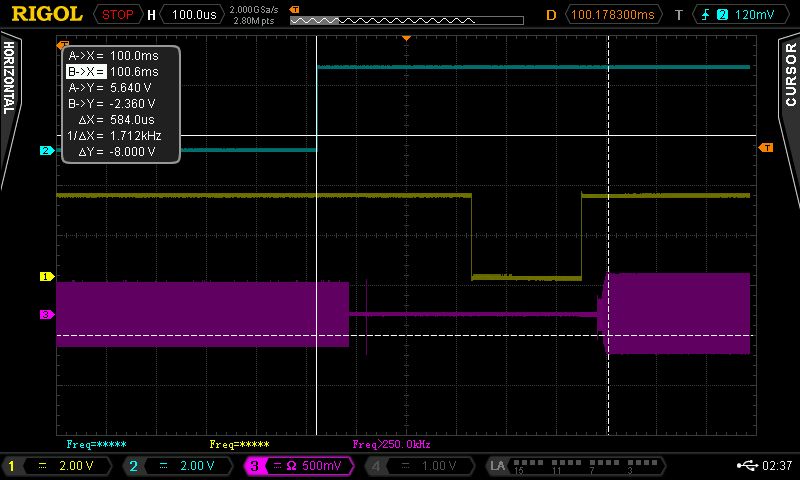Project update 5 of 12
Frequency Switching Speed
Frequency switching speed is defined as the time it takes for a signal generator (or a frequency synthesizer) to switch from one frequency to another. Frequency switching speeds of modern signal generators range from a few hundreds of nanoseconds to several hundred of milliseconds depending on the architecture and oscillator technology used. For example, one of the latest signal generators offered by Keysight, named UXG, has a frequency switching speeds as low as 180 ns. On the other hand, PSG series (possibly the purest microwave signal generator on the market) from the same manufacturer has around 9 ms.
Measurement
We used an oscilloscope to measure ERASynth Micro’s frequency switching speed:
The turquoise trace is the trigger signal. We set up a two-point triggered sweep using the touch screen. ERASynth Micro was switching between 13 MHz and 19 MHz at every trigger.
Yellow trace is the lock detect output on the main PLL. Note that a mere measurement of lock detect output would not be an accurate switching speed measurement because it only includes settling time of the PLL, i.e., doesn’t include the command processing time, time spent for calculations, attenuator settling time etc…
Pink trace is the ERASynth Micro’s RF output. As it can be seen from the image, it takes around 600 μs for ERASynth Micro to switch from 19 MHz to 13 MHz.
Comments
You might be wondering why we selected such low frequencies in the measurement. Why not measure the frequency switching speed at gigahertz frequencies? Well, for two reasons:
- It is extremely hard to sample the microwave frequencies if you are not one of those rich guys who can afford a 40 GSPS oscilloscope.
- There is no need to do so. ERASynth Micro has a fundamental VCO range of 3.2 to 6.4 GHz and the frequencies below 3.2 GHz are generated by using digital frequency dividers. In the case of 13 and 19 MHz, fundamental VCO output is divided by 256. So it is essentially the same thing to measure frequency switching speed between the following frequency pairs:
- 13 MHz and 19 MHz
- 3328 MHz and 4864 MHz
600 μs is respectable number for a signal generator considering the fact that we used an ATMEGA32U4 MCU to do all of the calculations and SPI transactions. Much better speed could be achieved if a more performant MCU with a higher clock was used.

